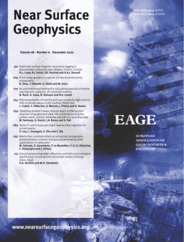
Full text loading...
 , Rosli Saad1
, Rosli Saad1 , Nazrin Rahman1
, Nazrin Rahman1 , Nur Azwin Ismail1
, Nur Azwin Ismail1
Various methods were earlier designed to calculate porosity of a formation, but many of them are reliant on physical soil sampling and/or laboratory measurements. The present work examines a recently proposed method, which we call here as Sample‐free Porosity Calculation from Resistivity Imaging Data (SPyCRID), to calculate porosity of unconsolidated soils. By conjoining Archie's and Waxman–Smits’ equations, SPyCRID can achieve high accuracy in porosity calculation, while requiring no physical soil‐sampling data. Two‐dimensional resistivity data acquired at Segantang Garam were modelled to calibrate SPyCRID's workflow and to devise data constraints for marine clay and brackish pore‐fluid conditions. Measured porosities from soil samples were used only for calibration and validation purposes. With data transformation added into the workflow, the performance of SPyCRID was improved as it was possible to achieve more precise value for the calculated porosity (error ≤3.1%). The final step to establish SPyCRID's competency was implemented through testing SPyCRID at the Nibong Tebal test site that has similar geological conditions to the model. Results from this test site showed nominal errors (≤3.9%) in the calculated porosity. SPyCRID could successfully calculate the porosity of the unconsolidated, marine clayey soils with a confidence limit exceeding 96%, while requiring no physical sampling data.

Article metrics loading...

Full text loading...
References


Data & Media loading...

